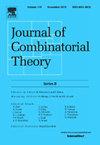互补棱柱的自形群
IF 1.2
1区 数学
Q1 MATHEMATICS
引用次数: 0
摘要
给定 n 个顶点上的有限简单图 Γ,其互补棱图是由Γ 及其互补图 Γ¯ 通过添加完美匹配而得到的图ΓΓ¯,其中每条边都连接 Γ 和 Γ¯ 中相同顶点的两个副本。它概括了彼得森图,如果 Γ 是五边形,就会得到彼得森图。对于任意图形 Γ,描述了 ΓΓ¯ 的自变群。特别是,它证明了 ΓΓ¯ 和 Γ 的自变群的心数之比只能达到 1、2、4 和 12 的值。研究表明,当且仅当Γ 是顶点传递的且自互补时,ΓΓ¯ 才是顶点传递的。此外,当 n>1 时,互补棱镜不是一个 Cayley 图。本文章由计算机程序翻译,如有差异,请以英文原文为准。
The automorphism group of a complementary prism
Given a finite simple graph Γ on n vertices its complementary prism is the graph that is obtained from Γ and its complement by adding a perfect matching where each its edge connects two copies of the same vertex in Γ and . It generalizes the Petersen graph, which is obtained if Γ is the pentagon. The automorphism group of is described for an arbitrary graph Γ. In particular, it is shown that the ratio between the cardinalities of the automorphism groups of and Γ can attain only the values 1, 2, 4, and 12. It is shown that is vertex-transitive if and only if Γ is vertex-transitive and self-complementary. Moreover, the complementary prism is not a Cayley graph whenever .
求助全文
通过发布文献求助,成功后即可免费获取论文全文。
去求助
来源期刊
CiteScore
2.70
自引率
14.30%
发文量
99
审稿时长
6-12 weeks
期刊介绍:
The Journal of Combinatorial Theory publishes original mathematical research dealing with theoretical and physical aspects of the study of finite and discrete structures in all branches of science. Series B is concerned primarily with graph theory and matroid theory and is a valuable tool for mathematicians and computer scientists.

 求助内容:
求助内容: 应助结果提醒方式:
应助结果提醒方式:


